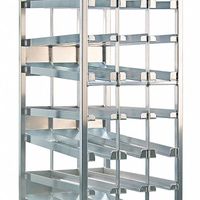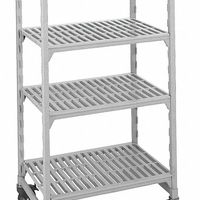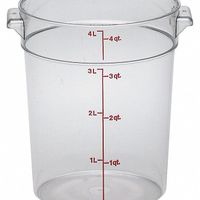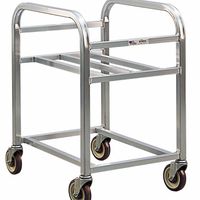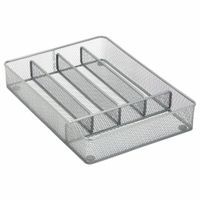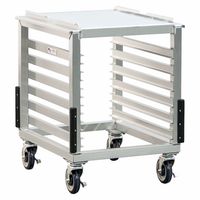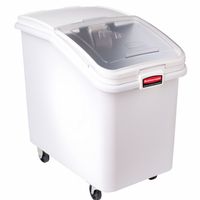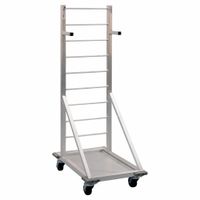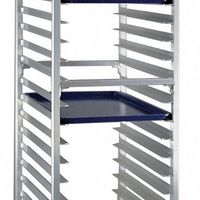Call +(254) 703 030 000 / 751 483 999 / 721 704 777
.....Read More
Frequently Asked Questions
What are the best containers for storing food?
The best containers for storing food are those that ensure freshness, prevent contamination, and are convenient for use. Glass containers are highly recommended due to their non-porous nature, which prevents odors and stains. They are also microwave and dishwasher safe, making them versatile and easy to clean.
Plastic containers, particularly those made from BPA-free materials, are lightweight and durable. They are ideal for dry goods and short-term storage. However, they can absorb odors and stains over time, so it's important to choose high-quality options.
Stainless steel containers are another excellent choice, especially for those concerned about plastic use. They are durable, non-reactive, and often come with airtight lids, making them suitable for both dry and wet foods.
For pantry storage, airtight containers are crucial to keep out moisture and pests. Options like glass jars with rubber seals or plastic containers with locking lids are effective.
Silicone bags are a sustainable alternative to single-use plastic bags. They are flexible, reusable, and can be used in the freezer, microwave, and dishwasher.
For freezing, containers that are freezer-safe and have tight seals are essential to prevent freezer burn. Glass or BPA-free plastic containers with snap-on lids work well.
Vacuum-sealed containers are excellent for extending the shelf life of perishable items by removing air, which slows down spoilage.
In summary, the best containers for storing food are those that are airtight, durable, and appropriate for the type of food being stored. Glass, BPA-free plastic, stainless steel, and silicone are all excellent materials to consider, depending on your specific needs and preferences.
How do I keep food fresh for longer?
To keep food fresh for longer, follow these strategies:
1. **Proper Storage**: Store perishable items in the refrigerator at or below 40°F (4°C). Use airtight containers to prevent moisture loss and contamination. For dry goods, use sealed containers to keep out pests and moisture.
2. **Temperature Control**: Keep your refrigerator and freezer at optimal temperatures. The freezer should be at 0°F (-18°C) or lower. Avoid overloading to ensure proper air circulation.
3. **Use the Crisper Drawers**: Store fruits and vegetables in the crisper drawers, which are designed to maintain humidity levels. Keep fruits and vegetables separate to prevent ethylene gas from accelerating spoilage.
4. **Wrap and Seal**: Use plastic wrap, aluminum foil, or beeswax wraps to cover cut fruits and vegetables. This prevents exposure to air and slows down oxidation.
5. **Vacuum Sealing**: Vacuum seal meats, cheeses, and other perishables to remove air and extend shelf life.
6. **Blanching and Freezing**: Blanch vegetables before freezing to preserve color, flavor, and nutrients. Cool them quickly in ice water before freezing.
7. **Use Preservatives**: Natural preservatives like lemon juice, vinegar, and salt can help extend the freshness of certain foods.
8. **First In, First Out (FIFO)**: Organize your pantry and fridge so that older items are used first. This reduces waste and ensures freshness.
9. **Avoid Cross-Contamination**: Keep raw meats separate from other foods to prevent bacterial spread.
10. **Check Expiry Dates**: Regularly check and consume items before they expire.
11. **Herb Preservation**: Store herbs in a glass of water in the fridge or freeze them in oil in ice cube trays.
12. **Bread Storage**: Keep bread in a cool, dry place or freeze it to prevent mold.
Implementing these practices will help maintain the freshness and quality of your food for a longer period.
What is the safest material for food storage containers?
Glass is considered one of the safest materials for food storage containers. It is non-porous, meaning it does not absorb food odors, flavors, or stains, and it does not leach chemicals into food, even when heated. Glass containers are also durable and can withstand high temperatures, making them suitable for use in microwaves, ovens, and dishwashers. Additionally, glass is recyclable and environmentally friendly.
Stainless steel is another safe option. It is non-reactive, does not leach chemicals, and is resistant to rust and corrosion. Stainless steel containers are durable and can be used for both hot and cold foods. However, they are not microwave-safe.
Food-grade silicone is also a safe choice. It is flexible, lightweight, and can withstand a wide range of temperatures. Silicone does not leach harmful chemicals and is often used for collapsible containers and lids.
BPA-free plastic containers are a safer alternative to traditional plastics. While they are lightweight and less prone to breaking, it is important to ensure they are labeled as BPA-free to avoid potential chemical leaching. However, even BPA-free plastics may release other chemicals when heated, so they are best used for cold storage.
In summary, glass is the safest material for food storage due to its non-reactive nature and versatility. Stainless steel and food-grade silicone are also excellent choices, while BPA-free plastics should be used with caution.
How do I organize my kitchen storage effectively?
1. **Declutter:** Start by removing items you no longer use or need. Donate or discard duplicates and expired products.
2. **Categorize:** Group similar items together, such as baking supplies, spices, canned goods, and utensils. This makes it easier to find what you need.
3. **Use Clear Containers:** Store dry goods like pasta, rice, and cereals in clear, airtight containers. This keeps them fresh and allows you to see when you’re running low.
4. **Label Everything:** Use labels to identify contents in containers and shelves. This helps maintain organization and ensures everything has a designated spot.
5. **Maximize Cabinet Space:** Use shelf risers, pull-out drawers, and lazy Susans to make the most of vertical space and improve accessibility.
6. **Organize Drawers:** Use dividers or trays to separate utensils, cutlery, and small gadgets. This prevents clutter and makes items easy to find.
7. **Utilize Wall Space:** Install hooks or magnetic strips for hanging pots, pans, and knives. This frees up counter and drawer space.
8. **Optimize Pantry Storage:** Arrange items by frequency of use, with everyday items at eye level. Use stackable bins or baskets for grouping similar items.
9. **Store Items by Zone:** Keep items close to where they’re used. For example, store pots and pans near the stove and dishware near the dishwasher.
10. **Regular Maintenance:** Periodically review and reorganize your kitchen to ensure it remains functional and clutter-free.
11. **Consider Accessibility:** Place frequently used items within easy reach and store less-used items in higher or lower cabinets.
12. **Use Door Space:** Attach racks or organizers to the inside of cabinet doors for additional storage of spices, lids, or cleaning supplies.
Can you store food in plastic containers?
Yes, you can store food in plastic containers, but there are important considerations to ensure safety and maintain food quality. Choose containers labeled as "food-grade" or "BPA-free" to avoid harmful chemicals leaching into food. BPA (Bisphenol A) is a chemical found in some plastics that can seep into food and beverages, potentially causing health issues.
When storing food, ensure the plastic container is appropriate for the type of food and storage conditions. For instance, some plastics are not suitable for high temperatures and can warp or release chemicals when heated. Therefore, only use microwave-safe containers for reheating food. Similarly, for freezer storage, use containers designed to withstand low temperatures to prevent cracking.
It's also important to consider the type of food being stored. Acidic foods, like tomatoes or citrus fruits, can cause certain plastics to degrade over time, potentially leading to contamination. In such cases, glass or stainless steel containers might be a better option.
Always ensure containers are clean and dry before use to prevent bacterial growth. Avoid using scratched or damaged containers, as these can harbor bacteria and may not seal properly, leading to spoilage.
For optimal food preservation, use airtight containers to prevent exposure to air and moisture, which can lead to spoilage and loss of flavor. Label containers with the date of storage to keep track of freshness and avoid consuming expired food.
In summary, while plastic containers can be a convenient and effective way to store food, selecting the right type and using them correctly is crucial for safety and maintaining food quality.
What are the best practices for storing baked goods?
To store baked goods effectively, follow these best practices:
1. **Cool Completely**: Ensure baked goods are completely cooled before storing to prevent condensation, which can lead to sogginess.
2. **Use Airtight Containers**: Store items like cookies, cakes, and muffins in airtight containers to maintain moisture and prevent them from drying out.
3. **Separate by Type**: Store different types of baked goods separately to avoid flavor transfer and maintain texture. For example, keep cookies away from cakes.
4. **Refrigeration**: Refrigerate items with perishable ingredients like cream cheese frosting or custard fillings. However, note that refrigeration can dry out bread and cakes, so it’s best for items that require it.
5. **Freezing**: For longer storage, freeze baked goods. Wrap them tightly in plastic wrap or aluminum foil, then place in a freezer bag. Thaw at room temperature when ready to use.
6. **Bread Storage**: Store bread in a bread box or a paper bag to maintain a balance of moisture and air circulation. Avoid plastic bags, which can make bread soggy.
7. **Avoid Sunlight and Heat**: Keep baked goods in a cool, dark place to prevent spoilage and staling.
8. **Use Wax or Parchment Paper**: Place wax or parchment paper between layers of cookies or bars to prevent sticking.
9. **Label and Date**: Clearly label and date stored items to keep track of freshness and avoid consuming stale goods.
10. **Refresh Before Serving**: For items like bread or pastries, refresh them in the oven for a few minutes to restore texture before serving.
By following these practices, you can extend the shelf life and maintain the quality of your baked goods.
How do I prevent food from spoiling in the fridge?
1. **Temperature Control**: Keep your fridge at or below 40°F (4°C) to slow bacterial growth. Use a thermometer to ensure accuracy.
2. **Proper Storage**: Store food in airtight containers to prevent contamination and moisture loss. Use clear containers to easily identify contents.
3. **Organize**: Place older items at the front and newer ones at the back to use them in order. Keep raw meats on the bottom shelf to prevent drips onto other foods.
4. **Humidity Settings**: Use crisper drawers with adjustable humidity settings. High humidity is ideal for leafy greens, while low humidity suits fruits.
5. **Avoid Overloading**: Do not overcrowd the fridge. Proper air circulation is essential for maintaining consistent temperatures.
6. **Clean Regularly**: Wipe spills immediately and clean the fridge regularly to prevent mold and bacteria buildup.
7. **Check Seals**: Ensure door seals are tight to prevent warm air from entering. Replace if worn out.
8. **Label and Date**: Label containers with contents and date of storage to keep track of freshness.
9. **Use Preservatives**: Consider using natural preservatives like lemon juice or vinegar for certain foods.
10. **Avoid Hot Foods**: Let hot foods cool before refrigerating to prevent raising the fridge's internal temperature.
11. **Monitor Expiry Dates**: Regularly check and discard expired items to prevent spoilage.
12. **Use Baking Soda**: Place an open box of baking soda in the fridge to absorb odors and keep it fresh.
13. **Defrost Regularly**: If your fridge is not frost-free, defrost it regularly to maintain efficiency.
14. **Keep Doors Closed**: Minimize the time the fridge door is open to maintain a stable temperature.
